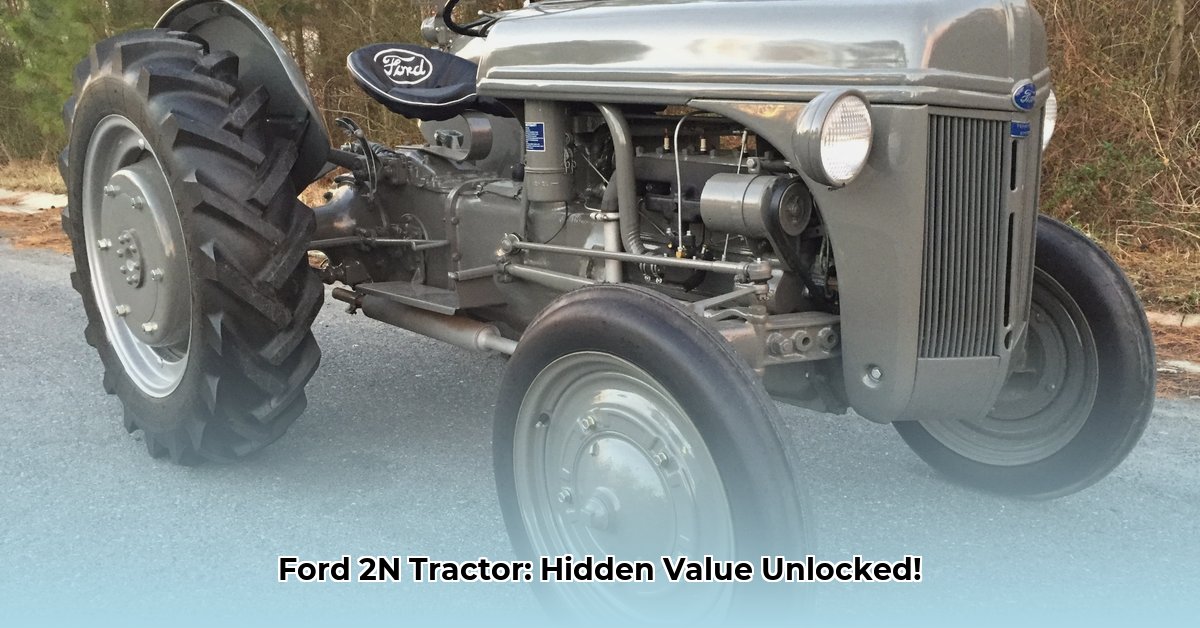
The Ford 2N tractor: a legend in the farming world and a coveted collectible. Whether you're a seasoned collector or a first-time buyer, understanding its value is crucial. This guide navigates the 2N market, from pricing trends to practical buying and selling advice. We'll cover everything you need to know to unlock the true worth of your 2N, regardless of its condition.
Market Overview: Deciphering 2N Ford Tractor Prices
The value of a vintage Ford 2N tractor is dynamic, influenced by several interconnected factors. The market encompasses both functional and collector's interest, creating a broad spectrum of pricing. Our analysis reveals three key drivers of value: year of manufacture, condition, and location. A pristine, fully restored 1940s model will command a substantially higher price than a partially disassembled project tractor from the 1950s. Similarly, regional demand influences values; a highly sought-after model in one region might fetch a lower price elsewhere.
What are the primary factors influencing Ford 2N tractor prices? Consider these key aspects when assessing value.
(Illustrative data – actual prices will vary considerably based on specific circumstances.)
| Factor | Auction Average Price (USD) | Private Sale Average Price (USD) | Standard Deviation (USD) |
|---|---|---|---|
| Working, 1948 | $5,000 | $7,500 | $1,500 |
| Restored, 1942 | $12,000 | $18,000 | $3,000 |
| Parts Tractor, 1950 | $1,000 | $1,500 | $500 |
The data clearly shows a significant difference between auction and private sale prices, reflecting the compressed timeframe and market pressures inherent in auction environments. Restoration efforts dramatically impact value, as demonstrated by the price difference between a "working" and "restored" tractor.
Assessing a 2N Tractor: A Comprehensive Inspection Checklist
Before buying or selling, a meticulous inspection is indispensable. This detailed checklist guides you through a comprehensive evaluation:
1. Visual Assessment: Begin with a thorough visual inspection of the entire tractor. Look for rust, corrosion, dents, scratches, missing parts, and the quality of any previous repairs. Poorly executed repairs are significant indicators of questionable maintenance history.
2. Engine Evaluation: Carefully inspect the engine for leaks (oil, fuel, coolant), which can signal underlying mechanical issues. Assess compression – low compression suggests wear and tear. A meticulously maintained engine speaks to the overall care the tractor has received.
3. Transmission and Gearbox Inspection: Shift through all gears and listen for any unusual noises (grinding, whining), which point to internal damage or wear. Smooth shifting indicates a well-maintained transmission.
4. Hydraulic System Check (if applicable): If equipped, test the hydraulics. Look for leaks and verify that the lift mechanism operates correctly and smoothly under load.
5. Documentation Review: Thorough documentation significantly impacts value. Seek ownership history, service records, and any evidence of previous restoration or significant repairs.
Pricing Strategies: Optimizing your Transaction
Effective pricing strategies are crucial for both buyers and sellers.
For Sellers: Thorough research is paramount. Consult recent sales data for similar tractors to determine a competitive yet realistic price. High-quality photos and comprehensive descriptions emphasizing condition, any restoration work, and unique features are vital for attracting buyers. Be prepared to negotiate.
For Buyers: Leverage online resources and local auctions to research market values. Compare comparable models to determine a fair price. Don't rush into a purchase—thorough investigation allows for informed decision-making.
Mitigating Potential Risks: Planning for the Unexpected
Owning a vintage tractor involves inherent risks. Proactive planning minimizes potential problems:
| Risk Category | Likelihood | Impact | Mitigation |
|---|---|---|---|
| Mechanical Breakdown | High | High | Regular maintenance, readily available parts, trusted mechanic |
| Parts Sourcing | Medium | Medium | Online forums, specialized suppliers, building a network of fellow owners |
| Unexpected Repair Costs | Medium | High | Pre-purchase inspection by a professional, setting aside a repair fund |
| Market Fluctuation | Low | Medium | Staying informed about market trends, sound financial planning |
Finding Parts and Resources: Leveraging the Community
Locating parts for a vintage 2N can be challenging but achievable. Online communities dedicated to Ford 2N tractors (example link) provide invaluable resources. Specialized suppliers and networking with fellow enthusiasts are also crucial sourcing strategies.
Legal and Regulatory Considerations: Navigating Local Laws
Understand local and state regulations regarding tractor operation, safety, and environmental compliance. Ensure all ownership transfers are properly documented and legally sound.
Conclusion: Due Diligence for Informed Decisions
The value of a Ford 2N tractor is multifaceted, depending on condition, age, and market dynamics. Thorough research, a detailed inspection, and savvy negotiation strategies are key to successful buying and selling. Remember, informed decisions protect your investment in this iconic piece of agricultural history.